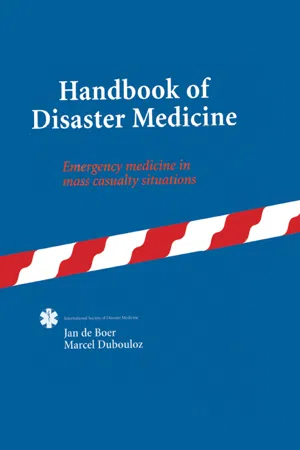2.1 Initial management in hospital
The general principles for the initial management in the hospital do not differ appreciably from the principles valid for prehospital management, and the same management regimen can be used. There are many such regimens described by different authors in different textbooks, and they all have advantages and disadvantages.
The programme used in the ATLS (Advanced Trauma Life Support) courses has been adapted by numerous doctors (and also other medical staff) all over the world. It has been well tested and evaluated in numerous incidents and types of trauma and is considered accurate. To avoid confusion, the way of working should be as uniform as possible and a programme with such a wide application can be well recommended.
The ATLS regimen has not been accepted uncritically. Its applicability in centres that deal with a heavy load of trauma has been questioned. In such centres, the different steps in trauma management are usually run in parallel by a large team of specialised physicians, nurses and technicians. When it comes to more primitive conditions with less experienced people, however, the ATLS regimen is of benefit and it has been clearly shown that its wide application has resulted in significant improvements in trauma care.
It is very important not only in the prehospital care, but also in the initial phase in hospital, to use simple measures, so simple they can also be used in hospitals that do not have access to adequate staff or equipment for optimal management of the patients. It is also important to train qualified staff in these simple measures as they may be called upon when there are many casualties, and they are often forgotten by doctors and nurses who are not used to working under primitive conditions. Such measures are:
– Simple diagnostic measures to evaluate breathing and circulation (clinical evaluation).
– Securing the airway by simple but correct positioning of the patient. There may not be resources for more advanced methods of airway control, and there may be no resources for continuous surveillance of the patient.
– Prevention of shock by correct positioning, avoiding cooling, and rapid control of every source of bleeding.
– Pain relief by proper immobilisation of fractures and careful and accurate management of the patient.
When there is a heavy load of injured patients, all these measures are applicable not only in the prehospital phase but also into the emergency room in the hospital. A simple regimen of management (such as the ATLS, which is known to all staff) should be followed.
The measures for control of a blocked, or potentially blocked, airway that are described for prehospital care (part III: chapters 6 and 7) should also be used in the primary management in the emergency room: clearing and suction of the airway, position of drainage, and nasopharyngeal tube. If airway control cannot be achieved in this way, ventilatory support should be started with bag – valve – mask ventilation, and the addition of oxygen (12 litres/minute) and endotracheal intubation should be considered.
In disasters or where there are many casualties, endotracheal intubation has to be done for more restricted indications. In patients with a poor prognosis (such as head injuries with no spontaneous ventilation) resources needed for endotracheal intubation and consequent surveillance may be better used for patients who have a better chance of survival. This means that in major accidents or disasters, consider the priority before doing an endotracheal intubation!
When doing endotracheal intubation, consider the risk of injury to the cervical spine (common in major trauma). If there is any suspicion or insecurity, apply a stiff collar before manipulating the neck (note that a stiff collar does not fully protect the neck!).
Inaccurate endotracheal intubation (insertion of a tube in the oesophagus or right main bronchus) are common errors among the less experienced. The position of the tube should always be carefully checked with auscultation of the chest, and (if possible) control of oxygenation. A cuff should always be used in adults, and an oropharyngeal tube should be inserted in parallel.
Deeply unconcious patients do not require drugs for intubation. In conscious patients, Ketamine is a good first choice, except in the case of head injuries when barbiturates could be the first choice.
If endotracheal intubation is indicated but is not possible because of severe maxillofacial injuries, oedema (burn) or severe bleeding, cricothyroidotomy should be considered. This can be done with simple instruments (knife, scissors) and the airway can be maintained and secured with simple devices.
If cricothyroidotomy is not done properly it can lead to strictures. Incisions should not encroach on the laryngeal or cricoid cartilages. Use a small horizontal incision in the membrane between the laryngeal cartilage and first cartilage, which can easily be palpated.
To gain time while waiting for more permanent securing of the airway with endotracheal intubation or cricothyroidotomy, a needle cricothyroidotomy could be done and oxygen given by the jet – insufflation technique: oxygen 15 litres/minute, intermittent insufflation with one second on plus 4 seconds off for a maximum of 30–45 minutes before permanent control of the airway can be achieved.
Note the risk of carbon dioxide accumulation, which merits special care with head injuries.
Whenever possible, oxygen should be given to all severely injured patients who require assisted ventilation (see above).
Pay attention to the chest: are there any
– Penetrating injuries?
– Contusions?
– Rib fractures?
– Subcutaneous emphysema?
Pneumothorax is common in severe trauma and may be immediately life threatening if it is turned into a tension pneumothorax (for example when starting assisted ventilation). Signs and measures: See under ‘Chest injuries’.
Multiple rib fractures may cause instability of the chest and cause respiratory insufficiency. Signs and measures: See under‘Chest injuries’.
